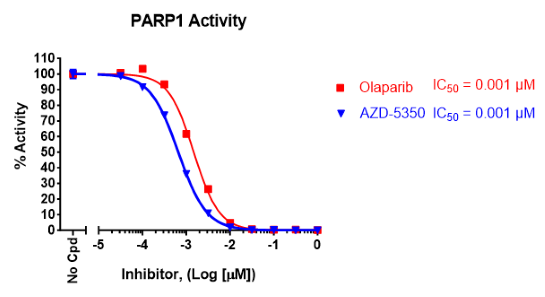PARP1 Chemiluminescent Assay Kit (384-well)
The PARP1 Chemiluminescent Assay Kit is designed to measure the activity of PARP1 (poly-(ADP-ribose) polymerase 1) for screening and profiling applications. The PARP1 assay kit comes in a convenient 384-well format, with enough recombinant purified PARP1 enzyme, reaction substrates, and PARP assay buffer for 400 enzyme reactions.

Figure 1. PARP1 Chemiluminescent Assay Kit schematic.
Histone proteins are coated on a 384-well plate. Next, a biotinylated NAD+ mix (termed PARP Substrate Mixture) is incubated with the PARP1 enzyme and an activated DNA template in an optimized assay buffer. The plate is then treated with streptavidin-HRP followed by addition of the ELISA ECL substrate to produce chemiluminescence that can be measured using a chemiluminescence reader. The chemiluminescence signal is proportional to PARP1 activity.
Need us to run inhibitor screens or profile your compounds against PARP1? Check out our PARP/PARPTrap™ Screening Services or DNA Replication and Repair Services.
This product has been cited 13 times.
- 1x PBS (Phosphate Buffer Saline) Buffer
- PBST Buffer (1x PBS, containing 0.05% Tween-20)
- Luminometer or microplate reader capable of reading chemiluminescence
- Adjustable micropipettor and sterile tips
- Rotating or rocker platform
| Catalog # | Name | Amount | Storage |
| 80501 | PARP1, GST-Tag* | 2 x 1 µg | -80°C |
| 52029 | 5x Histone Mixture | 2 x 1 ml | -80°C |
| 78366 | PARP Substrate Mixture 1 | 2 x 250 µl | -80°C |
| 80602 | 10x PARP Assay Buffer | 2 x 1 ml | -20°C |
| 79743 | Blocking Buffer 3 | 2 x 25 ml | +4°C |
| 80605 | Activated DNA | 2 x 20 µl | -80°C |
| 0.5 M DTT | 2 x 200 µl | -20°C | |
| 80611 | Streptavidin-HRP | 2 x 100 µl | +4°C |
| 79670 | ELISA ECL Substrate A (translucent bottle) | 2 x 6 ml | Room Temp |
| ELISA ECL Substrate B (brown bottle) | 2 x 6 ml | Room Temp | |
| 78188 | 384-well white plate | 1 | Room Temp |
*The concentration of the protein is lot-specific and will be indicated on the tube.
PARP1, also known as poly-(ADP-ribose) polymerase 1 or NAD+ ADP-ribosyltransferase 1, is part of the PARP family, and it is the most abundant member. ADP ribosylation, which is the addition of an ADP-ribose to a protein, is a reversible post-translational modification of proteins mostly involved in the DNA Damage Response (DDR) pathway. Poly-ADP-ribosylation (termed PARylation) is the addition of linear or branched chains of ADP-ribose. PARP1 participates in DNA repair by non-homologous end joining (NHEJ), homologous recombination (HR), microhomology-mediated end-joining (MMEJ) and nucleotide excision repair. Dysfunction of DDR pathways can lead to oncogenesis. Overexpression of PARP1 has been found in breast and colon cancer, neuroblastoma, and others. This overexpression can lead to increasing MMEJ, an error-prone DNA repair mechanism, and genome instability leading to cancer. In addition to being involved in DDR, PARP1 is also linked to inflammation and type I diabetes. PARP1 inhibitors have been used in cancer treatment with success. In addition to reducing MMEJ, the use of PARP1 inhibitors can lead to synthetic lethality when homologous recombination repair (HRR) mechanisms are already defective, as in the case of BRCA1 (breast cancer susceptibility protein type 1) and BRCA2 deficient cells. Further understanding of the molecular pathways involving PARP1, and this contribution to disease, will continue to pave the way for new therapies for PARP1-linked diseases.
Marques M., et al., 2019 Oncogene 38 (12): 2177-2191.


